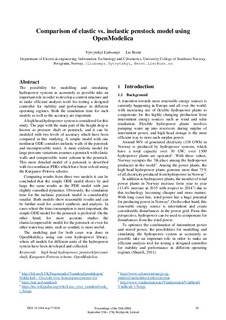| dc.contributor.author | Vytvytskyi, Liubomyr | |
| dc.contributor.author | Lie, Bernt | |
| dc.date.accessioned | 2018-01-24T10:20:15Z | |
| dc.date.available | 2018-01-24T10:20:15Z | |
| dc.date.created | 2017-10-11T12:57:59Z | |
| dc.date.issued | 2017 | |
| dc.identifier.citation | Linköping Electronic Conference Proceedings. 2017, (138), 20-28. | nb_NO |
| dc.identifier.issn | 1650-3686 | |
| dc.identifier.uri | http://hdl.handle.net/11250/2479320 | |
| dc.description.abstract | The possibility for modelling and simulating hydropower systems as accurately as possible take an important role in order to develop a control structure and to make efficient analysis tools for testing a designed controller for stability and performance in different operating regimes. Both the simulation time for such models as well as the accuracy are important. A high head hydropower system is considered for this study. The pipe with the main part of the height drop is known as pressure shaft or penstock, and it can be modeled with two levels of accuracy which have been compared in this studying. A simple model with one nonlinear ODE considers inelastic walls of the penstock and incompressible water. A more realistic model for large pressure variations assumes a penstock with elastic walls and compressible water column in the penstock. This more detailed model of a penstock is described with two nonlinear PDEs which have been solved using the Kurganov-Petrova scheme. Comparing results from these two models it can be concluded that the simple ODE model shows by and large the same results as the PDE model with just slightly smoothed dynamics. Obviously, the simulation time for the inelastic penstock model is considerably smaller. Both models show reasonable results and can be further used for control synthesis and analysis. In cases where the time consumption is most important, the simple ODE model for the penstock is preferred. On the other hand, for more accurate studies the elastic/compressible model for the penstock or even for other waterway units, such as conduit, is more useful. The modeling part for both cases was done in OpenModelica using our own hydropower library, where all models for different units of the hydropower system have been developed and collected. | nb_NO |
| dc.language.iso | eng | nb_NO |
| dc.rights | Navngivelse-Ikkekommersiell 4.0 Internasjonal | * |
| dc.rights.uri | http://creativecommons.org/licenses/by-nc/4.0/deed.no | * |
| dc.title | Comparison of elastic vs. inelastic penstock model using OpenModelica | nb_NO |
| dc.type | Journal article | nb_NO |
| dc.type | Peer reviewed | nb_NO |
| dc.description.version | publishedVersion | nb_NO |
| dc.source.pagenumber | 20-28 | nb_NO |
| dc.source.journal | Linköping Electronic Conference Proceedings | nb_NO |
| dc.source.issue | 138 | nb_NO |
| dc.identifier.doi | 10.3384/ecp1713820 | |
| dc.identifier.cristin | 1503785 | |
| cristin.unitcode | 222,58,2,0 | |
| cristin.unitname | Institutt for elektro, IT og kybernetikk | |
| cristin.ispublished | true | |
| cristin.fulltext | original | |
| cristin.qualitycode | 1 | |

